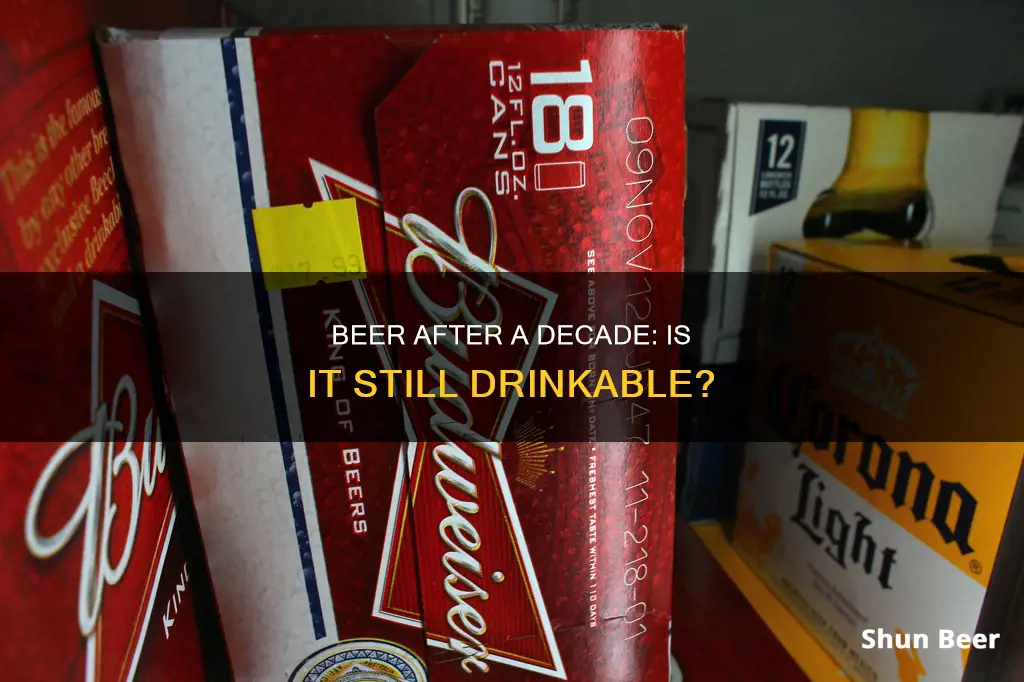
Beer typically has a 'best before' date, which is different from a 'use by' date. While it's not advisable to drink beer past its 'use by' date, it's generally safe to consume beer that has exceeded its 'best before' date. However, the taste and quality of the beer will likely have deteriorated, and it may be flat or stale. The higher the alcohol content, the less concerned you need to be with the use-by date.
What You'll Learn

Beer doesn't expire in the same way milk does
Beer typically has a 'best before' date, rather than a 'use by' date. This means that while beer can expire, it doesn't go off in the same way that fresh foods like milk do. You won't find it turning sour, growing mould, or going green. Instead, it will slowly lose its flavour and quality over time.
The fermentation process used in brewing, as well as the low pH level and alcohol content of beer, make it an unfriendly environment for bacteria. Even if a beer sits on the shelf for years, as long as it's sealed, it's unlikely to make you sick. However, the taste of beer changes over time, and it can become unpleasant to drink.
There are a few signs that your beer has gone bad. If it has lost its fizz, this is a tell-tale sign that the seal was broken at some point, and the flavour will be compromised. Beer that has gone bad might smell bad, or be missing the usual 'pssst' sound and foaming when you open it. There might also be excessive sediment at the bottom of the bottle, which can contribute to a poor taste.
To keep your beer fresh for as long as possible, it's important to store it in a cool, dark place, preferably the refrigerator. If you're storing beer at room temperature, make sure it's not exposed to direct sunlight. It's also best to store beer bottles upright, to minimise the surface area exposed to air inside the bottle.
Kicking the Beer Habit: Losing Weight and Gaining Health
You may want to see also

Beer is unlikely to make you sick, even if it's years old
Beer typically has a 'best before' date, which is different from a 'use by' date. While the former is a guideline on quality, the latter is a rule that must be followed to avoid degradation and bacterial build-up. This means that even if your beer is past its 'best before' date, it is unlikely to make you sick.
The fermentation process used in brewing, along with the low pH level and alcohol content of beer, creates an environment that is unconducive to the growth of harmful pathogens and bacteria. This makes it safe to consume even if it has been sitting on the shelf for years, as long as it remains sealed.
However, it is important to note that the taste of beer can change over time. While some beers improve with age, similar to wine and whiskey, others, such as IPAs, gradually lose their flavour and aroma. Additionally, exposure to oxygen, heat, and light can cause the beer to go bad and develop an unpleasant taste.
To ensure the best quality and taste, it is recommended to consume beer as close to its release or "born-on" date as possible. Proper storage is also crucial; beer should be kept in a cool, dark place, preferably a refrigerator, and upright to minimise exposure to oxygen.
Wheat-Free, Beer-Friendly: Enjoying Beer Without Wheat
You may want to see also

The taste of old beer will change
Beer typically has a 'best before' date, which is different from a 'use by' date. While the former is a guideline on quality, the latter is a rule on food safety. This means that while beer can be consumed past its 'best before' date, it is not advisable to consume it after its 'use by' date.
Light is another factor that can cause the beer to develop a skunk-like flavour. Beer ages poorly under ultraviolet light, so it is best to store beer in brown bottles, aluminium cans, or dark places.
Drinking Non-Alcoholic Beer: Is It Safe to Drive?
You may want to see also

Beer should be stored in a cool, dark place
Beer can be stored for years if kept in the right conditions. The key to long-term beer storage is to keep the beer in a cool, dark place.
Beer is sensitive to changes in temperature, so it's important to store it in a place where the temperature remains relatively constant. Major changes in temperature, such as moving beer from an ice-cold cooler to a hot car, can cause the beer to go bad. The ideal temperature for storing beer is between 45° F and 55° F, which is colder than room temperature but warmer than a refrigerator. If you don't have access to a temperature-controlled space, storing beer in a refrigerator is the next best option.
In addition to temperature, light is also a factor that can affect the quality of beer. Beer ages poorly under ultraviolet light, so it's important to store it in a dark place. Brown bottles and aluminium cans are effective at blocking out light, while clear or light-coloured bottles will allow UV rays to penetrate and cause the beer to develop a skunky flavour.
By controlling the temperature and light exposure, you can extend the shelf life of beer and preserve its flavour and quality. This is especially important for certain types of beer, such as IPAs, which are best consumed within a few months of packaging to fully enjoy their hoppy goodness.
When storing beer, it's also recommended to keep the bottles or cans upright, as this minimises the surface area exposed to oxygen, which can cause oxidation and affect the flavour of the beer.
Beer and Sleep: Enemies or Friends?
You may want to see also

The higher the alcohol content, the less concerned you need to be with the use-by date
Beer typically has a 'best before' date, which is different from a 'use by' date. 'Use by' dates are more of a rule, and after the stated date, the product should not be consumed due to safety concerns. On the other hand, 'best before' dates are more of a guideline on quality rather than safety. This means that the beer will start to lose its quality in terms of taste and aroma over time but can still be consumed.
The higher the alcohol content in a beer, the less concerned you need to be with the use-by date. This is because alcohol, along with the beer's low pH and the antimicrobial activity of hops, creates an environment where harmful pathogens or bacteria cannot survive. Therefore, a beer with higher alcohol content is less likely to spoil and can be consumed past its 'best before' date.
However, it is important to note that the taste of beer, especially the hoppiness and aromas, will change over time. Beers with lower alcohol content and hoppy beers, such as IPAs, are more likely to lose their flavour and aroma and should be consumed closer to their 'best before' date.
Additionally, proper storage is crucial to maintaining the quality of beer. Beer should be stored in a cool, dark place, preferably in a refrigerator, to prevent oxidation and the development of a stale or cardboard-like flavour. Heat and light can also negatively impact the taste of beer, with heat speeding up the oxidation process and light causing a skunky flavour.
Understanding Beer Extracts: The Science Behind the Brew
You may want to see also
Frequently asked questions
Yes, you can. The 'best before' date is a guideline on quality rather than safety. Beer doesn't expire like milk does. However, the taste of the beer will change over time.
It depends on the type of beer. A typical lager will be drinkable 6-24 months after its best before date if it's been kept in the fridge. That timeframe is up to 9 months if it hasn't been refrigerated. Beers with higher alcohol content tend to have greater longevity.
There will be a bad aroma, and it might be missing the usual 'pssst' sound and foaming when you open it. There could also be excessive sediment at the bottom of the bottle, contributing to a poor taste.
Keep it in a cool, dark place, preferably a refrigerator. If you're storing it at room temperature, make sure it's not in direct sunlight. Also, leave the beers standing upright to reduce exposure to oxygen.
Yes, beer packaged in clear or light-coloured bottles will develop a skunk-like flavour over time. Brown bottles and aluminium cans are better at blocking out light.







